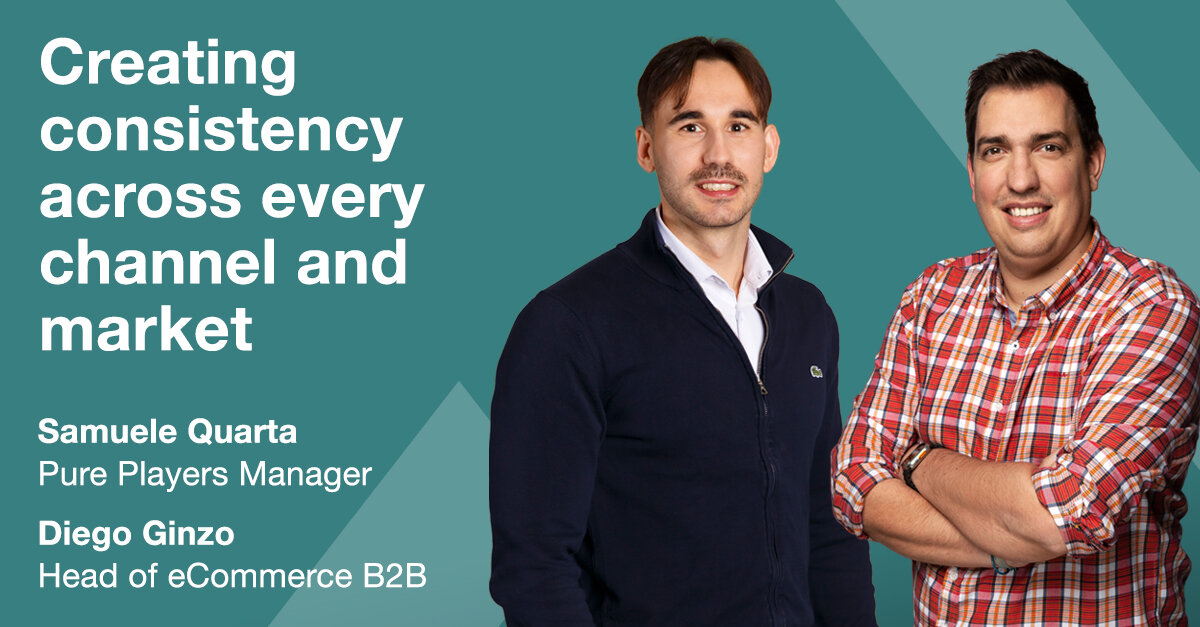
Search jobs
Help to shape the digital future of one of the world’s best-loved brands.
As the retail sector moves increasingly online, Miele X is developing new eCommerce strategies to ensure that Miele products are marketed consistently across every channel and in every market around the world. It’s a complex challenge, so we sat down with Diego Ginzo, Miele X’s Head of eCommerce B2B, and Samuele Quarta, Pure Players Manager, to find out more.

Diego has been at Miele X since December 2022, but, as he explains, the focus of his role has already changed. “When I joined, my role focused on Amazon and Pure Players – retailers who make most of their sales online and don’t have any physical stores. But now, we’re looking at eCommerce B2B for all relevant online sales channels, including click and mortar – retailers with both physical and online sales channels. It’s an important change of strategy, because click and mortar is still the biggest sales channel for Miele. So, we needed to ensure holistic support for every single eCommerce platform, rather than individual retailers.”
He says another key driver behind this change of focus was the global nature of Miele’s business. “At Miele X, we try to create synergies and know-how that we can share with the different Miele country teams. For us, that’s really important.” And he adds that this works particularly well in areas such as performance marketing because his teams can test how content promoting Miele products on different retailers’ sites performs in various markets and produce data to guide future strategy.
He outlines how this approach allows Miele X to localise all content, using the right keywords for each country, to optimise performance. “And then we go through the overall content syndication, putting the content onto the right platforms for the best distribution. We are leading this to give the retailers the ultimate content solution that we produce as a company.”
Global strategy with a local personality
In his first six months at Miele X, Samuele says he’s seen the advantage of having a central hub in terms of sharing best practice and insights. “The country teams used to run local activities and there was no information sharing. Now, we take a ‘test and learn’ approach to support campaign optimisation or different campaign structures for various sales platforms. And if we find any wins, we cascade them to other markets.”
This has helped the Miele country teams, says Diego, because they were only used to seeing what was happening in their own area. “I think they see it as an opportunity. Before, they only saw a trend when it hit their country, which might be earlier or later than somewhere else. By creating this international community, we know what’s happening in all our markets, and having these insights allows us to build ad hoc strategies for every single market.”
He says this is all part of their strategy to move from silos to a more communal approach. “What we really want is to have the key people sitting in the same room, pooling information and then having open discussions about what we can do differently.” As an example, he says all the country heads of eCommerce B2B are getting together at Miele X’s Community Space in Amsterdam to plan the 2024 strategy. And he sees this as a chance to identify a range of efficiencies to support profitability across different channels and markets.
Building partnerships
This idea of bringing people together is a thread that runs through all their work. Samuele says his team's main goal is to create connections between sales, marketing and content. “We start by looking at marketing-oriented metrics like growth or ROI. While we’re interested in pure marketing performance, we always want to contextualize the results by looking at the final traffic figures and, most importantly, the final sales. To do this, we basically need to connect the dots between the different teams and align all our KPIs.”
As an example of how this works, he details how his team recently started looking at both sales figures and inventory levels for specific products to guide content. “So, if we know that a product is selling well on both Amazon and click and mortar, but there are low levels of stock, it doesn’t make sense to continue promoting it,” he explains. Before, with standalone retail marketing and sales teams, he says this wasn’t possible.
He further explains that building partnerships outside Miele X is equally important, as they’re also working with third-party tool providers to help improve the retailers’ technological capabilities. “The tool providers cannot accomplish this independently, so they require our support to speed things up. Not many brands are pushing this, so they value our partnership.”
And Diego explains how Miele’s partnerships with the retailers benefit both their brands. “For example, product returns have a huge impact because they are usually linked to negative reviews. We have several tools to help us understand shopper behaviour. Really studying what they say about us helps us to do things better. And we know that everything is a part of the cycle, so good reviews mean fewer returns and more sales. So, we understand that having the right content on the retailer’s site is really important. This makes Miele an easy account to manage.”
These insights into their target consumers also help in other ways. Samuele says they use customer insights from reviews to feed into the media strategy. “The retailers have the advantage of access to lots of first-party data, and we can build customer profiles based on this data. This means we can check things like average income per market and per product category, or which lifestyle audiences are more relevant for our products in each market.” He adds that it’s all about bringing content, sales, pricing and marketing strategies together to build the right customer persona and then combining this with the retailers’ unique media inventory. “Based on these insights, we allocate our budgets smartly to drive more qualified traffic, which helps increase our efficiency.”
This is important for Diego because these newly gained insights allow them to help stakeholders across Miele to understand consumers better. “Running campaigns like this means we can offer insights to improve sell-through or initial sales. For example, we can reach out to the product brand managers and say: ‘In this country, this product was bought by people from this age group, with a minimum household income of this amount.’ So having insights like these allows us to drive sales.”
Looking to the future
For Samuele, the most exciting challenge on the horizon is the opportunity to explore markets such as Asia–Pacific and the Middle East. From a retail marketing perspective, he says Miele X also wants to be one of the first brands to use new tools. “Our partnerships with third-party tool providers mean we could have access to features such as machine learning or artificial intelligence technology. It’s very dynamic, so we need to build strong relationships with the retailers, retail media networks and technology providers, to ensure we’re ready and can react quickly to any changes.”
Diego says his team has several KPIs, but the key ones are to drive short-term sales and achieve long-term value. He adds that delivering efficiencies and a positive ROI are equally important. “If we deliver the same sale numbers year over year, but with 46% less budget, I’d say it’s good. But one of our key messages in the short-term is to change the mindset of the organisation, from country level to global, so when we launch innovations such as eco-friendly features, we have the right performance marketing strategy and content to make sure shoppers are aware of them.”
He says that to achieve this, they had to evolve their strategy from a previous focus on five countries where Amazon was present to focusing on other B2B players in other regions. “This has given us a solid foundation that makes it easier to expand our strategy and ways of working into even more regions. So, we are supporting new countries to help them introduce the same approach, look and feel across every single market. The next phase is to continue evolving and to onboard the rest of the markets to the same level. After all, this is an ongoing project.”